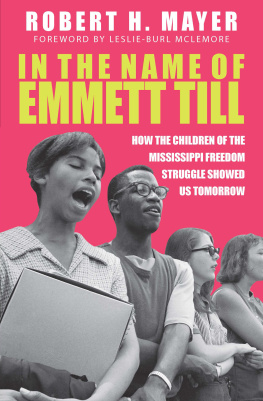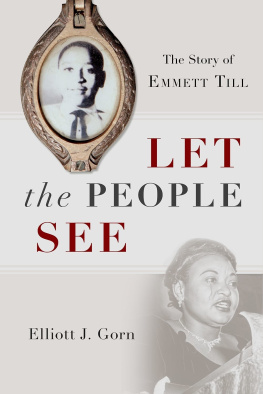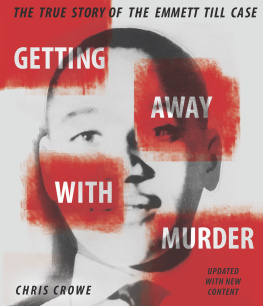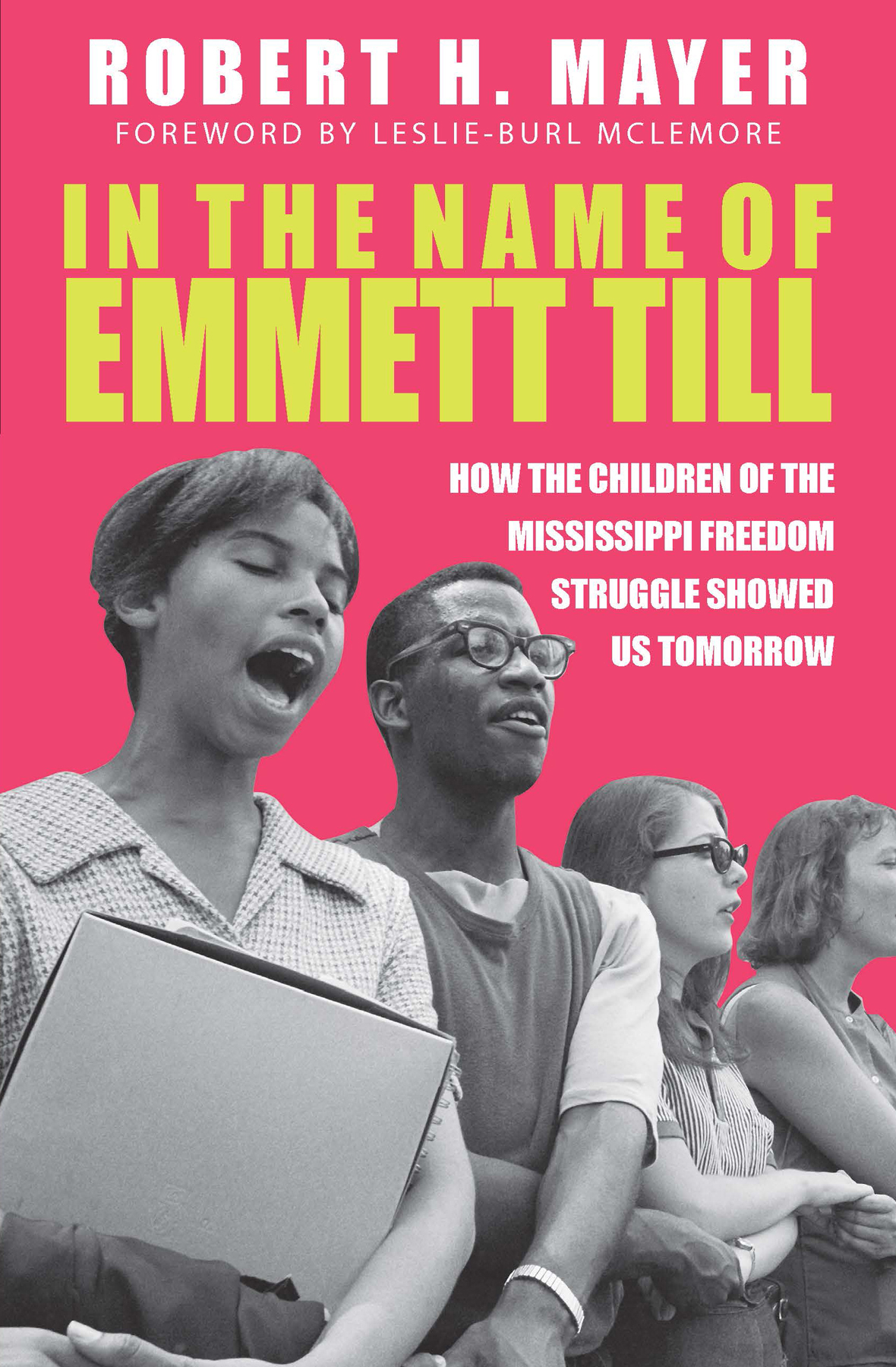Table of Contents
Guide
In the Name of Emmett Till
ALSO BY ROBERT H. MAYER
When the Children Marched:
The Birmingham Civil Rights Movement
The Civil Rights Act of 1964
In the Name of Emmett Till
How the Children of the Mississippi Freedom Struggle Showed Us Tomorrow
ROBERT H. MAYER
FOREWORD BY LESLIE-BURL MCLEMORE
NEWSOUTH BOOKS
Montgomery
NewSouth Books
105 S. Court Street
Montgomery, AL 36104
Copyright 2021 by Robert H. Mayer
All rights reserved under International and Pan-American Copyright Conventions.
Published in the United States by NewSouth Books, Montgomery, Alabama.
LIBRARY OF CONGRESS CATALOGING-IN-PUBLICATION DATA
Names: Mayer, Robert H., 1950, author.
Title: In the name of Emmett Till : how the children of the Mississippi freedom struggle showed us tomorrow / Robert H. Mayer.
Description: Montgomery, AL : NewSouth Books, [2021] | Includes bibliographical references and index. | Audience: Ages: 1218 | Audience: Grades: 612.
Identifiers: LCCN 2021001808 (print) | LCCN 2021001809 (ebook) | ISBN 9781588384379 (hardback) | ISBN 9781588384454 (ebook)
Subjects: LCSH: African AmericansCivil rightsMississippiHistory20th centuryJuvenile literature. | Civil rights movementsMississippiHistory20th centuryJuvenile literature. | African American civil rights workersMississippiHistory20th centuryJuvenile literature. | African American student movementsMississippiHistory20th centuryJuvenile literature. | African American youthMississippiSocial conditions20th centuryJuvenile literature. | MississippiRace relationsHistory20th centuryJuvenile literature.
Classification: LCC E185.93.M6 M275 2021 (print) | LCC E185.93.M6 (ebook) | DDC 323.1196/0730762dc23
LC record available at https://lccn.loc.gov/2021001808
LC ebook record available at https://lccn.loc.gov/2021001809
Design by Randall Williams
Printed in the United States of America by Sheridan

| The Black Belt, defined by its dark, rich soil, stretches across central Alabama. It was the heart of the cotton belt. It was and is a place of great beauty, of extreme wealth and grinding poverty, of pain and joy. Here we take our stand, listening to the past, looking to the future. |
To Noah, Seth, and Katherine
Contents
LESLIE-BURL MCLEMORE
The Mississippi civil rights movement has produced a number of remarkable leaders over the last sixty years. These then young and now much older people blazed a multitude of trails in the state. Most of them emerged from small towns and rural communities. They uniformly grew up in the Black church and many were active in the Youth Councils of the National Association for the Advancement of Colored People (NAACP). In addition, some were members of the Hi-Y and Tri-Hi-Y organizations founded to foster and develop leaders in the Black high schools throughout the state of Mississippi. Of course, some were members of the Future Farmers of America and the 4-H club. Their one commonality was a strong desire to change the status quo in Mississippi.
The young leaders identified in this book were active in the 1950s and 1960s. They were influenced by NAACP field secretary Medgar Wiley Evers, who organized NAACP chapters across Mississippi. Training from Evers and his colleagues taught these young people how to conduct a meeting and organize a protest march. From 1954 to 1963, Evers was the primary civil rights leader in Mississippi. He worked with civil rights organizations and churches throughout the state. He had a reputation for willingness to work with anyone who was dedicated to bringing justice and progress to the State of Mississippi.
The stories of Amos Brown, Johnny Frazier, and Dorie and Joyce Ladner began with their association with Evers in their high schools. Evers worked closely with the NAACP youth councils in the respective communities. Needless to say, the youth council advisors played pivotal roles in the development of young people. The Ladner sisters give tremendous credit to advisor Clyde Kennard in the development of their leadership skills. Kennard went to prisonon a trumped-up charge of stealing chicken feed brought because he had tried to enroll at the University of Southern Mississippi. Amos Brown and Johnny Frazier were also assisted by adult leaders in their communities. Sam Bailey played a major role in working with youth in Jackson. To a person, all would say that they had supportive parents and a favorite teacher or teachers who encouraged them to stand up and speak up for justice and freedom.
The Tougaloo Nine were introduced to Evers after their enrollment at Tougaloo College in Jackson, Mississippi. Author Robert Mayer notes that Evers recruited and trained the Nine to participate in a read-in at the Jackson public library on March 27, 1961. That read-in was one of the first civil rights protests in Mississippi in the 1960s. Of course, we know that students at Jacksons Lanier High School had boycotted the local city buses in the 1940s and that students at Rust College in Holly Springs had boycotted the local segregated movie theater in 1960.
The arrival in Mississippi of the Student Nonviolent Coordinating Committee (SNCC) helped to change the states civil rights landscape in a profound way. The young SNCC field secretaries went into rural communities and small towns in southwest Mississippi, Jackson, Hattiesburg, and the Mississippi Delta. SNCC ushered in the mass movement in Mississippi, advocating voter registration and direct action. Indeed, SNCC launched a direct action campaign in McComb in 1961. McComb is where we were introduced to Hollis Watkins, Brenda Travis, Curtis Hayes (Muhammad), Billy Talbert, Ike Lewis, and others.
Bob Moses, Marion Barry Jr., Chuck McDew, Reggie Robinson, Bob Zellner, and other SNCC members came to McComb in the summer of 1961. The SNCC influence helped to elevate the movement to another level. Moses and his colleagues profoundly impacted the young people in McComb and southwest Mississippi. Brenda Traviss heroic story is an example of the courageous leadership demonstrated by young people throughout Mississippi. Travis became the symbol of youth leadership in McComb. Needless to say, the aforementioned young people were at the forefront of the movement.
Robert Mayers offering is a wonderful introduction to some of those young people who helped to make the Mississippi Movement a reality. The book should encourage all of us to learn more about these young people and the Mississippi movement. It goes without saying that as fascinating as are the stories Mayer has highlighted, he easily could have profiled several other young leaders from the 1950s and 1960s. For instance, the role that Lawrence Guyot of the Mississippi Freedom Democratic Party played, and the on-the-ground efforts of Johnnie Harris, Lee Dilworth, William Scott, Raymond Davis, Rosie Purdy, and many others at Rust College in Holly Springs.
Nonetheless, Mayer has made a major contribution to the literature on the roles of young people in the Mississippi Movement. It is hoped that his contribution will be complemented by stories to come from others with an interest in the fascinating Mississippi story.
Long-time activist Leslie-Burl McLemore was a SNCC field secretary, vice chair of the 1964 Mississippi Freedom Democratic Partys delegation, a city council member and interim mayor of Jackson, a founder of the Fannie Lou Hamer Institute on Citizenship and Democracy, and a professor and interim president of Jackson State University. His doctorate is from the University of Massachusetts (Amherst) and he is also a proud graduate of Mississippis Rust College
Next page











